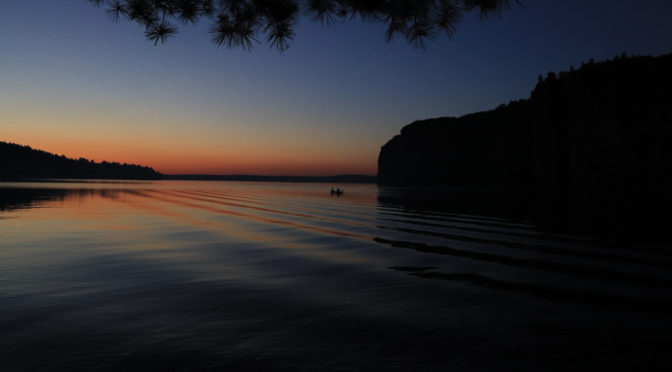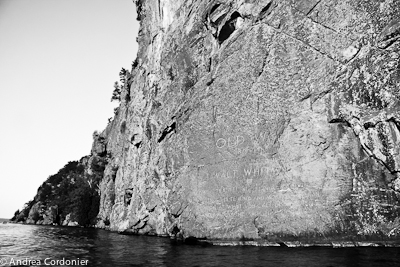My foothold is tenon’d and mortised in granite/I laugh at what you call dissolution/And I know the amplitude of time.
– WALT WHITMAN, 1819-1919, carved on a rock face at Bon Echo Provincial Park, Mazinaw (Massanoga), Ontario
I am intrigued by, and not a little envious of, the concept of an artists’ retreat anchored deep in raw nature. Although it’s possible to somewhat find one’s intellectual and artistic tribe online nowadays or through book clubs, arts events, universities or other societies, I can think of a no more delicious way to spend an extended period of time than chatting, exploring and (temporarily) living with engaging and gifted people from a variety of backgrounds. And if you are the host or hostess, the panoply of an ever-changing guest list would be flat-out bedazzling. Overwhelming, perhaps, but never boring.
According to Robert Stacey and Stan McMullin, the authors of Massanoga: The Art of Bon Echo, Flora MacDonald Denison, a journalist, dress-maker, theosophist, spiritualist, feminist and Whitmanite purchased the existing Bon Echo Inn in 1910 from Dr. Weston Price of Cleveland, with the desire to commune in nature with complementary creative minds.
The site was remote for the time, twenty miles from the nearest rail station and forty miles from purveyors of groceries and building supplies. Dr. Price built the entire kit and caboodle in just two seasons but sold it upon the sudden death of his young son. The built property consisted of:
a main building…five cottages, a separate staff house, several tent platforms…and service buildings…a boathouse (with) 25 rowboats, canoes and launches spent the winter, a laundry, an icehouse, a combined water-tower and workshop with quarters for the staff on the upper floors. In addition…Dr. Price found time to build a rustic bridge across the narrows and an iron stairway to the top of the Rock, string a telephone line from the Inn to Kaladar station and construct two large docks, flanked by covered pavilions on the lower and upper lakes. There was even a piano, which fell off a lumber wagon on the Bald Mountains and spent a night in the ditch.
A scale model of the main residence in the park’s visitor centre shows an ample, handsome two-and-a-half-storey frame building with a turret and wrap around decks.
Dr. Price may have built the inn, but Flora MacDonald and her son Merrill, himself a writer, playwright and amateur painter, furnished it with a Who’s Who of Canadian and American artists, writers and progressive thinkers. These included: R. J. Drummond; John Wilson Bengough; F. M. Bell-Smith; Frank Hans Johnston; C. W. Jefferys; John William Beatty and Alice Amelia Innes; Doris Huestis Mills; Arthur Lismer; A. Y. Jackson; Dorothy Stevens; Franklin Carmichael and A. J. Casson; Charles Fraser Comfort; and Eric Aldwinckle. Frederick Hagan came later, under his own steam. Then Margaret Ford and John Mortensen arrived at the invitation of the Friends of Bon Echo, who established an Artist in Residence program in 1993 to carry on the MacDonald/Denisons’ artistic and cultural traditions. As one of Canada’s most popular painting sites, works made at Bon Echo can be found in many private and public collections across Canada and around the world. Once you’ve seen an image of the Rock, in a painting or photograph, others become easily recognizable.
Flora’s muse was great American poet Walt Whitman who “gave voice to her deepest beliefs about human freedom and fellowship, life and death.” She founded the Whitman Club of Bon Echo in 1915 and memorialized Whitman through the spirit of the Rock, by engaging two Scottish stonemasons to chisel a dedication and a few lines of his poetry onto a dominant face just above the waterline. Horace Traubel, one of Whitman’s literary executors, was present at the opening ceremony and died almost immediately afterward, having, apparently, been visited by the spirit of Whitman who beckoned him to the sweet hereafter. This new piece of permanent artwork was flanked on each side, along the entire length of the immense rock, by the ochre-coloured pictographs of early First Nations people. Obviously it was a favoured place of community long before Flora’s arrival.
Merrill Denison and his wife, Muriel Goggin, took over the inn after Flora’s untimely death from pneumonia at the age of 54. They managed the inn until 1928 when, due to financial difficulties, the property was foreclosed and let to a boys’ camp, before being sold to a private corporation. It burned down in 1936. Three of the original buildings survive and are used for a visitors centre, a giftshop and the Cabin on the Hill, private accommodation that can be rented during the season. A cairn exists where the main building once sat, although there are no visible signs of a foundation or footings. Ashes to ashes it went, like the inevitability of all things, save for the rock face engravings.
While the life of the artistic retreat at Lake Mazinaw has passed, the magnificent nature surrounding it – its original inspiration – has not.
[nggallery id=13]

